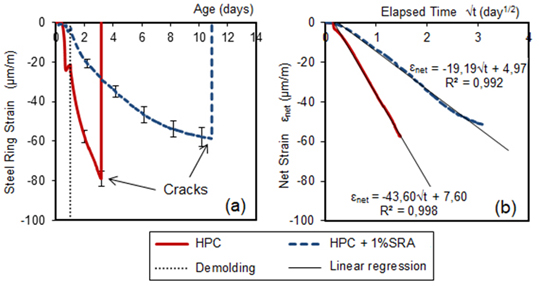Laboratory
CRACKING POTENTIAL
Restrained Ring Test acc. to ASTM C1581

The Restrained Ring Test is a method standardized in the United States under ASTM C1581, used to define the potential of cement composites to cracking as a result of drying shrinkage or autogenous shrinkage during the hardening phase. This method measures the circumferential deformation of steel rings caused by the clamping of concrete ring samples around the steel. The geometry of the steel and concrete rings is carefully selected to proportionally generate edge tensile stresses, which ultimately cause the concrete sample to crack once its tensile strength is exceeded. This allows for a comparison of the deformation development and the cracking time of the samples, enabling the classification of the potential of cement composites to cracking [1-4]. The steel rings are calibrated according to the author's measurement procedure [5], which is covered by a patent claim [6]. Deformations of the steel ring are recorded automatically at controlled intervals from the moment the sample is molded until cracking occurs or up to 28 days. Currently, our laboratory has 6 digital test stations. It is also possible to test the tensile strength of concrete ring samples, simulating the effects of shrinkage [7]. Additionally, we conduct tests at controlled ambient temperatures, with temperature measurements taken in the samples. Below is an example of a measurement:

Study on the effect of SRA on the potential of concrete to cracking using the restrained ring test method: (a) measured development of steel ring strain, (b) linear regression analysis and calculation of the average strain rate coefficient [4].
-------------------------
[1] A. Zieliński, M. Kaszyńska, Analiza procesu pękania betonów samozagęszczalnych w wyniku oddziaływań skurczowych. s. 443-465, 2016, ISBN: 978-83-61331-24-7. Conference materials: Dni Betonu: tradycja i nowoczesność, Stowarzyszenie Producentów Cementu, Wisła, 10-11 października 2016, Kraków, Polska.
[2] A. Radlińska, M. Kaszyńska, A. Zieliński, H. Ye, Early-age cracking of self-consolidating concrete with lightweight and normal aggregates, Journal of Materials in Civil Engineering, 30(10), s. 1-9, 2018, ISSN: 0899-1561, DOI: 10.1061/(ASCE)MT.1943-5533.0002407
[3] A. Zieliński, A.K. Schindler, M. Kaszyńska, Cracking risk of high-performance cement composites due to restrained autogenous shrinkage with and without soaked lightweight aggregate, Archives of Civil Engineering 2023;4(4):603-618. DOI: 10.24425/ace.2023.147679
[4] A. Zieliński, A.K. Schindler, 2024. Shrinkage Cracking Potential of Cement Composites Assessed by The Restrained Ring Test, 31st International Conference on Structural Failures, May 20-24, 2024, Międzyzdroje, Poland.
[5] A. Zieliński, M. Kaszyńska, Calibration of Steel Rings for the Measurement of Strain and Shrinkage Stress for Cement-Based Composites, Materials, 13(13), 2963, s. 1-15, 2020, ISSN 1996-1944, DOI: 10.3390/ma13132963
[6] A. Zieliński, R. Wojtaszewski, M. Kaszyńska, Method for the calibration of measuring rings used for measuring their deformability in result of the shrinking deformation of poured-in materials and the system for the calibration of measuring rings used for measuring their deformability in result of shrinking deformation of poured-in materials. Polish patent PL225785, registered on 02.04.2014 and published on 31.05.2017. https://patents.google.com/patent/PL225785B1
[7] A. Zieliński, R. Wojtaszewski, M. Kaszyńska, Method for measuring tensile strength of rings made from composite materials under the impact of external pressure and the test stand for measuring tensile strength of rings made from composite materials under the impact of external pressure. Polish patent PL229553, registered on 31.12.2015 and published on 31.07.2018. https://patents.google.com/patent/PL229553B1



